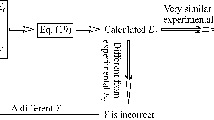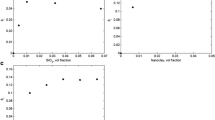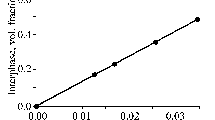Abstract
This work suggests a modeling method based on micromechanical models such as Pukanszky one to determine the interphase properties in ternary polymer nanocomposites containing two nanofillers. The developed models can calculate the volume fraction, thickness and strength of interphases between nanoparticles and polymer matrix using the experimental data of Young’s modulus and yield strength. The properties of interphases are calculated and discussed for polypropylene/montmorillonite (Mt)/CaCO3 ternary polymer nanocomposites at different nanofiller contents (2, 4 and 6 wt % of Mt and 2, 8, 14 and 20 wt % of CaCO3). The developed models demonstrate that the thickness of interphase differently depends on nanofiller size and volume fractions of nanofiller and interphase. In addition, it is shown that the strength of interphase directly correlates to the interfacial interaction/adhesion between nanoparticles and polymer matrix.


Similar content being viewed by others
REFERENCES
Miyagawa, H., Rich, M.J., and Drzal, L.T., Amine-Cured Epoxy/Clay Nanocomposites. II. The Effect of the Nanoclay Aspect Ratio, J. Polymer Sci. B. Polymer Phys., 2004, vol. 42, pp. 4391–4400.
Zare, Y. and Rhee, K.Y., Evaluation and Development of Expanded Equations Based on Takayanagi Model for Tensile Modulus of Polymer Nanocomposites Assuming the Formation of Percolating Networks,Phys. Mesomech., 2018, vol. 21, no. 4, pp. 351–357.
Badamshina, E.R., Goldstein, R.V., Ustinov, K.B., and Estrin, Ya.I., Strength and Fracture Toughness of Polyurethane Elastomers Modified with Carbon Nanotubes, Phys. Mesomech., 2018, vol. 21, no. 3, pp. 187–192.
Zare, Y. and Rhee, K.Y., Multistep Modeling of Young’s Modulus in Polymer/Clay Nanocomposites Assuming the Intercalation/Exfoliation of Clay Layers and the Interphase between Polymer Matrix and Nanoparticles, Composites. A. Appl. Sci. Manufactur., 2017, vol. 102, pp. 137–144.
Zare, Y. and Rhee, K.Y., A Power Model to Predict the Electrical Conductivity of CNT Reinforced Nanocomposites by Considering Interphase, Networks and Tunneling Condition, Compos. B. Eng., 2018, vol. 155, pp. 11–18.
Zare, Y. and Rhee, K.Y., Simplification and Development of McLachlan Model for Electrical Conductivity of Polymer Carbon Nanotubes Nanocomposites Assuming the Networking of Interphase Regions, Compos. B. Eng., 2019, vol. 156, pp. 64–71.
Rostami, A., Vahdati, M., and Nazockdast, H., Unraveling the Localization Behavior of MWCNTs in Binary Polymer Blends Using Thermodynamics and Viscoelastic Approaches, Polymer Compos., 2018, vol. 39, pp. 2356–2367.
Javidi, Z., Tarashi, Z., Rostami, A., and Nazockdast, H., Role of Nanosilica Localization on Morphology Development of HDPE/PS/PMMA Immiscible Ternary Blends, eXPRESS Polymer Lett., 2017, vol. 11, p. 362.
Farahi, A., Najafpour, G.D., and Ghoreyshi, A., Enhanced Ethanol Separation by Corona-Modified Surface MWCNT Composite PDMS/PES. PVP Membrane, JOM, 2019, vol. 71, pp. 285–293.
Golovnev, I.F., Golovneva, E.I., and Utkin, A.V., A Study into the Temperature and Size Effects in Nanostructures on Their Fracture under External Mechanical Loads, Phys. Mesomech., 2018, vol. 21, no. 6, pp. 523–528. doi 10.1134/S1029959918060073
Chehrazi, E., Sharif, A., Omidkhah, M., and Karimi, M., Modeling the Effects of Interfacial Characteristics on Gas Permeation Behavior of Nanotube–Mixed Matrix Membranes, ACS Appl. Mater. Interfaces, 2017, vol. 9, pp. 37321–37331.
Razavi, R., Zare, Y., and Rhee, K.Y., A Two-Step Model for the Tunneling Conductivity of Polymer Carbon Nanotube Nanocomposites Assuming the Conduction of Interphase Regions, RSC Advances, 2017, vol. 7, pp. 50225–50233.
Liu, Z., Peng, W., Zare, Y., Hui, D., and Rhee, K.Y., Predicting the Electrical Conductivity in Polymer Carbon Nanotube Nanocomposites Based on the Volume Fractions and Resistances of the Nanoparticle, Interphase, and Tunneling Regions in Conductive Networks, RSC Advances, 2018, vol. 8, pp. 19001–19010.
Chehrazi, E., Raef, M., Noroozi, M., and Panahi-Sarmad, M., A Theoretical Model for the Gas Permeation Prediction of Nanotube-Mixed Matrix Membranes: Unveiling the Effect of Interfacial Layer,J. Membrane Sci., 2019, vol. 570, pp. 168–175.
Shokri-Oojghaz, R., Moradi-Dastjerdi, R., Mohammadi, H., and Behdinan, K., Stress Distributions in Nanocomposite Sandwich Cylinders Reinforced by Aggregated Carbon Nanotube, Polymer Compos., 2019, vol. 40, no. 52, pp. E1918–E1927.
Khoramishad, H., Khakzad, M., and Fasihi, M., The Effect of Outer Diameter of Multi-Walled Carbon Nanotubes on Fracture Behavior of Epoxy Adhesives, Sci. Iran. Trans. B. Mech. Eng., 2017, vol. 24, pp. 2952–2962.
Khoramishad, H., Ebrahimijamal, M., and Fasihi, M., The Effect of Graphene Oxide Nano-Platelets on Fracture Behavior of Adhesively Bonded Joints, Fatigue Fract. Eng. Mater. Struct., 2017, vol. 40, pp. 1905–1916.
Zare, Y., Shear, Bulk, and Young’s Moduli of Clay/Polymer Nanocomposites Containing the Stacks of Intercalated Layers as Pseudoparticles, Nanoscale Res. Lett., 2016, vol. 11, p. 479.
Zare, Y. and Rhee, K.Y., Expression of Normal Stress Difference and Relaxation Modulus for Ternary Nanocomposites Containing Biodegradable Polymers and Carbon Nanotubes by Storage and Loss Modulus Data, Compos. B. Eng., 2019, vol. 158, pp. 162–168.
Bakhtiari, S.S.E., Karbasi, S., Tabrizi, S.A.H., and Ebrahimi-Kahrizsangi, R., Chitosan/MWCNTs Composite as Bone Substitute: Physical, Mechanical, Bioactivity, and Biodegradation Evaluation, Polymer Compos., 2019, vol. 40, p. E1622.
Zare, Y., Garmabi, H., and Rhee, K.Y., Prediction of Complex Modulus in Phase-Separated Poly (Lactic Acid)/Poly (Ethylene Oxide)/Carbon Nanotubes Nanocomposites, Polymer Test., 2018, vol. 66, pp. 189–194.
Zare, Y. and Rhee, K.Y., A Two-Step Technique for Tensile Strength of Montmorillonite/Polymer Nanocomposites Assuming Filler Morphology and Interphase Properties, Appl. Clay Sci., 2017, vol. 150, pp. 42–46.
Zare, Y., Rhim, S., Garmabi, H., and Rhee, K.Y., A Simple Model for Constant Storage Modulus of Poly (Lactic Acid)/Poly (Ethylene Oxide)/Carbon Nanotube Nanocomposites at Low Frequencies Assuming the Properties of Interphase Regions and Networks, J. Mech. Behavior Biomed. Mater., 2018, vol. 80, pp. 164–170.
Fornes, T. and Paul, D., Modeling Properties of Nylon 6/Clay Nanocomposites Using Composite Theories, Polymer, 2003, vol. 44, pp. 4993–5013.
Zare, Y. and Rhee, K.Y., Development of Hashin–Shtrikman Model to Determine the Roles and Properties of Interphases in Clay/CaCO3/PP Ternary Nanocomposite, Appl. Clay Sci., 2017, vol. 137, pp. 176–182.
Zare, Y. and Garmabi, H., A Developed Model to Assume the Interphase Properties in a Ternary Polymer Nanocomposite Reinforced with Two Nanofillers, Compos. B. Eng., 2015, vol. 75, pp. 29–35.
Yanovsky, Yu.G., Kozlov, G.V., and Karnet, Yu.N., Fractal Description of Significant Nanoeffects in Polymer Composites with Nanosized Fillers. Aggregation, Phase Interaction, Reinforcement,Phys. Mesomech., 2013, vol. 16, no. 1, pp. 9–22.
Pukanszky, B., Influence of Interface Interaction on the Ultimate Tensile Properties of Polymer Composites,Composites, 1990, vol. 21, pp. 255–262.
Zare, Y. and Rhee, K.Y., Expansion of Kolarik Model for Tensile Strength of Polymer Particulate Nanocomposites as a Function of Matrix, Nanoparticles and Interphase Properties, J. Colloid Interface Sci., 2017, vol. 506, pp. 582–588.
Zare, Y. and Rhee, K.Y., Modeling of Viscosity and Complex Modulus for Poly (Lactic Acid)/Poly (Ethylene Oxide)/Carbon Nanotubes Nanocomposites Assuming Yield Stress and Network Breaking Time,Compos. B. Eng., 2019, vol. 156, pp. 100–107.
Zare, Y. and Rhee, K.Y., Tensile Modulus of Polymer/CNT Nanocomposites Containing Networked and Dispersed Nanoparticles,AIChE J., 2018, vol. 64, pp. 220–225.
Hassanzadeh-Aghdam, M., Ansari, R., Mahmoodi, M., and Darvizeh, A., Effect of Nanoparticle Aggregation on the Creep Behavior of Polymer Nanocomposites, Compos. Sci. Technol., 2018, vol. 162, pp. 93–100.
Ma, X., Zare, Y., and Rhee, K.Y., A Two-Step Methodology to Study the Influence of Aggregation/Agglomeration of Nanoparticles on Young’s Modulus of Polymer Nanocomposites, Nanoscale Res. Lett., 2017, vol. 12, p. 621.
Zare, Y., Rhee, K.Y., and Park, S.-J., A Modeling Methodology to Investigate the Effect of Interfacial Adhesion on the Yield Strength of MMT Reinforced Nanocomposites, J. Indust. Eng. Chem., 2018, vol. 69, pp. 331–337.
Zare, Y. and Rhee, K.Y., Evaluation of the Tensile Strength in Carbon Nanotube-Reinforced Nanocomposites Using the Expanded Takayanagi Model, JOM, 2019, pp. 1–9.
Zare, Y. and Garmabi, H., Modeling of Interfacial Bonding between Two Nanofillers (Montmorillonite and CaCO3) and a Polymer Matrix (PP) in a Ternary Polymer Nanocomposite, Appl. Surf. Sci., 2014, vol. 321, pp. 219–225.
Author information
Authors and Affiliations
Corresponding author
Additional information
Russian Text © The Author(s), 2019, published in Fizicheskaya Mezomekhanika, 2019, Vol. 22, No. 4, pp. 101–107.
Rights and permissions
About this article
Cite this article
Zare, Y., Rhee, K.Y. & Park, SJ. Simple Models for Interphase Characteristics in Polypropylene/Montmorillonite/CaCO3 Nanocomposites. Phys Mesomech 23, 182–188 (2020). https://doi.org/10.1134/S1029959920020101
Received:
Revised:
Accepted:
Published:
Issue Date:
DOI: https://doi.org/10.1134/S1029959920020101




